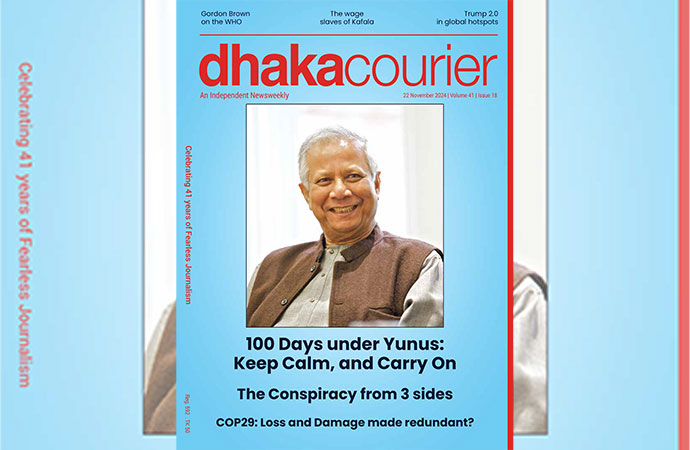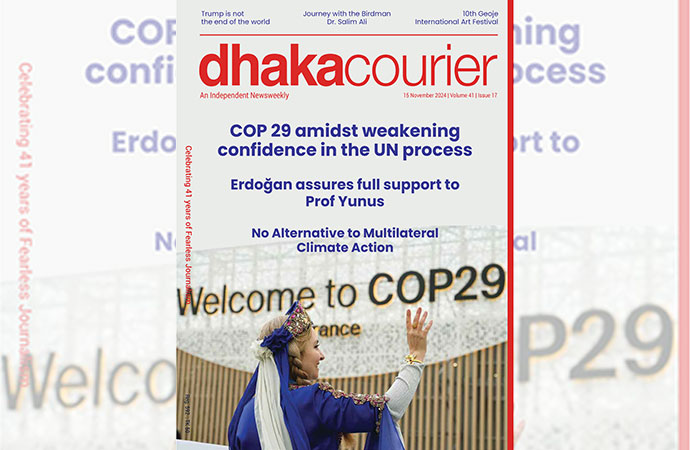Society

Prime Minister Sheikh Hasina observes, while then the chief whip Abul Hasanat Abdullah and Parbatya Chattagram Jana Samhati Samiti (PCJSS) President Santu Larma sign the Peace Accord of the Chittagong Hill Tracts, on December 2, 1997. Photo: Collected
The historic Chittagong Hill Tracts (CHT) treaty (better known as the 'Peace Accord') was signed between the government and the Jana Samhati Samiti on December 2, 1997. The treaty officially ended the two-era-long (the late-1970s-late-1990s) bloody conflict in the CHT. Although the conflict formally has ceased, the conflict has not ended in the hills. Instead, it has become more widespread in number and scale, which lies largely between the non-implementation of the treaty and the persistence of prejudiced perspectives.
Although two eras of the treaty have already passed, peace has not yet been reinstated in the green hills as expected. Various terrorist activities, including bloody clashes, killings, extortion, murder, and kidnapping, still commonly prevail in the hilly areas. The victims are ordinary people who want peace to live well in their own land. However, according to Jana Samhati Samiti that signed the treaty, the implementation of some clauses of the treaty gave hope to the indigenous hill people (Pahari). But even though the present Awami League government (that signed the treaty in 1997) has been in power for 12 consecutive years (a total of about 15 years after the treaty), all the clauses of the treaty have not been accordingly implemented, while various activities contrary to the treaty and against the interests of the Pahari are making the hills troubled again. Once the fountains of violence flowed through the green hills in the Pahari-Bengali conflict, the infinite conflict between the regional organizations' (internal organizations among Paharis) is staining the blood of the impeccably beautiful mountain life rich in natural diversity.
Incidentally, the non-implementation of the treaty and the existing conflict is due to the internal strife and atrocious situation, which has kept all the concerned parties, including the government authorities, more attentive in resolving the conflict than implementing the treaty. Many blamed 'intra-conflict' as one of the main causes of the post-treaty conflict. It is to be noted that soon after signing the treaty, a new regional alliance called United People's Democratic Front (UPDF) was formed under Prasit Bikash Khisa. Most of its leaders and activists were former activists of JSS. Then in the 1/11 situation in 2007, JSS split, and JSS (MN Larma) was formed under the leadership of Sudha Sindu Khisa. That part is known locally as the reformist party of the JSS. In addition, in 2017, a reformist faction of the UPDF, led by Tapan Jyoti Chakma, formed a new party called the UPDF (Democratic). As a result, murders and disappearances have become a daily occurrence in the internal conflicts in the remote hills. The situation is such that no one is safe now. Eventually, no one is surprised at being killed by anyone at any time.
Twenty-four years have already passed since the agreement was signed; Many basic and important issues remain unresolved. Although it has officially ended the armed conflict between the Paharis, the Bengalis, and the security forces, it cannot be said that now peace prevails in the hills. Moreover, 'the absence of violence is not peace'. The Pahari-Bengali are all still living in panic, where fear has become a part of their lives! The post-treaty CHT has yet to become a peaceful region for its inhabitants. On the one hand, there are allegations that the fundamental issues were not included in the treaty or resolved. The slow pace of implementation or even the fact that the written clauses have not been properly implemented has tarnished the potential hopes of the treaty.
The following problems are responsible for the ongoing conflict in the mountains which have hindered the passage of the existing turbulent situation: (a) faults in the treaty; (B) non-acceptance of the treaty by a section of Paharis; (C) continuous displacement; (D) intra-ethnic (JSS-UPDF etc.) conflicts and conflicts over supremacy and domination; (E) military intervention everywhere; (F) lack of political will; (G) non-implementation of essential provisions; (H) mistrust and animosity between the two adversaries (Pahari and Bengali), and (i) unchanging attitude towards the socio-culture of the hills and its inhabitants.
It should be noted here that the treaty was signed without the opinion of the locals. Both the hill and Bengali communities in the CHT were unaware of the final form, terms and signatures of the treaty, which was executed in a hurry. The underlying issues of the conflict were also not adequately addressed in the treaty, such as land disputes, punishment of human rights violators, reciprocal views, etc. Another critical point is that the position of the military in the treaty and the issues of the local/settler Bengalis were not adequately clear. At present, however, Bengalis make up about half of the CHT population. So, the treaty cannot be successful without considering their issues. Mutual mistrust and animosity between the Paharis and the Bengalis cannot be eradicated unless comprehensive measures are taken to resolve the crisis and establish communal harmony. As a result, the roads to peace in the hills have become more difficult.
Over the past twenty-four years, there has been widespread visible development, many areas of tourism have been created. In return, many of the ancient traditions of the hills are on the verge of extinction today. Instead of peace, the ongoing conflict has become more evident there. Because the existence of peace is far away from the hills. Today fear and apprehension have become integral part of the daily life of hill people. Peace or peaceful coexistence is another thing. With development or infrastructure, it has never been possible to establish peace anywhere. Here too, it has been observed in the CHT. In this situation, how many clauses have been implemented, or the improved roads or buildings cannot measure peace in the hilly region. Bringing qualitative change, not visual ones, is the main challenge and the need of the time.
Given that the CHT problem must be viewed not only from a security point of view but also from ethnoecological and cultural diversity, preserving and upholding this rich diversity by implementing the treaty's terms and taking holistic steps to change the existing conflict situation qualitatively. From a numerical point of view, the benefits of the treaty cannot be reaped. To move forward, a qualitative move is a must. There is no substitute for implementing fundamental issues aimed at creating qualitative change toward mutual trusts, such as land dispute settlement, where all the conflicts of Pahari-Bangali lie. The Land Commission Act was enacted in 2001 to settle land disputes. This commission is still 'working' without any desired progress. Then the law was amended again in 2016, but the Paharis have not benefited in this regard to date. Relevant rules have not been finalized yet.
On the other hand, although the Chittagong Hill Tracts Regional Council Act was enacted in 1998, the rules have not been enacted even after two decades. After two decades, it is not appropriate to keep them waiting. The non-full implementation of the CHT treaty has caused frustration among the people, leading many to believe that intra-ethnic conflict and widespread conflict situations have emerged in the hills.
In the name of development and tourism, the land acquisition, destruction of jum cultivation, the destruction of nature introducing tobacco cultivation, etc., must be stopped. These are harmful to the hills and a threat to nature and sustainable development across the country. Bangladesh has been a multiethnic country. This reality has to be acknowledged and realized effectively, with required steps to maintain ethnic diversity and to uplift their cultures and heritages. That is why the issue of ethnic diversity needs state recognition including necessary cooperation and incentives. We have to abandon hegemonic thinking and work with an inclusive attitude towards all. Therefore, inclusive steps need to be taken for speedy implementation of the treaty.
The attitude of the majority towards the Paharis needs to be changed as well. This should not be limited to the hills, but applies to the mainstream people across the country. We have to come out from the 'nativist' point of view and superiority-inferiority complex. Instead of punitive transfer, we have to give work opportunities to the officials who are fond of indigenous society and culture in the hills. The tendency to blame the Paharis (e.g., 'the staple foods of Chakma are rice and wine' or misconceptions about the eating habits of the Paharis created during the coronavirus outbreak- living like the Chinese) must be stopped. At the same time, the Paharis have to be positive towards their counterpart Bengalis. A mindset toward social cohesion and peaceful coexistence must be created. The treaty will not remove misunderstandings and create harmony between the two communities. To do it, integrated measures are needed in every sector including education, health, and the workplace.
Until now, the 1997 treaty failed to bring significant change to the CHT. Therefore, there are two equal possibilities in the existing situation: (a) a return to ethnic conflict or continuity of conflict, and (b) a move towards peaceful coexistence. If proper measures are not taken for the second one, the first possibility is inevitable. If the necessary steps are not taken in time and maintained properly, the ongoing misery will continue. Appropriate steps to involve people from all walks of life (all ethnic groups, all parties: JSS and UPDF, security forces, 'indigenous'/old Bengalis, settled Bengalis, etc.) are undeniable prerequisites for moving forward on the path to peace. Although the treaty is a formal procedure, its scope is profound and holistic. Issues that are not covered in the treaty have to be addressed, going beyond the clauses, through informal dialogue and flexible programs. Misunderstandings and mistrust between Paharis and Bengalis must be eliminated; simultaneously, the dilemma and suspicion between different ethnic groups must be removed through the regular course of the dialogue, participation, etc. The impact of globalization and the politico-economic aspects must also be included in the process.
Even after two eras, we must apprehend that the failure to contain and carry the lessons of the absence of peace will be even more horrendous. If peace is not established after the potential paths of peace have been opened, the situation is highly likely to go out of control - that is the lesson of history. The question now is whether to learn from history!
Professor, Department of Anthropology, University of Chittagong, and Researcher on CHT. Email: alactg@gmail.com

























Leave a Comment
Recent Posts
CA Yunus to hold talks with Ti ...
Foreign Affairs Adviser Md Touhid Hossain on Sunday met President of T ...
Cold wave disrupts daily life ...
Bangladesh is currently facing its first tangible cold wave of the sea ...
Bangladesh set to celebrate Victory Day Monday
Can the environment adviser save us from Dhaka’s tox ..
The International Monetary Fund
Fifa confirmed Saudi Arabia's hosting of the men's 2 ..